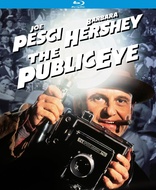The Public Eye Blu-ray Movie
HomeThe Public Eye Blu-ray Movie 
Kino Lorber | 1992 | 99 min | Rated R | Jul 28, 2020Movie rating
6.6 | / 10 |
Blu-ray rating
| Users | 0.0 | |
| Reviewer | 3.5 | |
| Overall | 3.5 |
Overview
The Public Eye (1992)
Story of a 1940s photographer who specializes in crime and in not getting involved... until this time.
Starring: Joe Pesci, Barbara Hershey, Stanley Tucci, Jerry Adler, Dominic ChianeseDirector: Howard Franklin
| Thriller | Uncertain |
| Crime | Uncertain |
| Drama | Uncertain |
| Romance | Uncertain |
Specifications
Video
Video codec: MPEG-4 AVC
Video resolution: 1080p
Aspect ratio: 1.85:1
Original aspect ratio: 1.85:1
Audio
English: DTS-HD Master Audio 2.0
Subtitles
English SDH
Discs
Blu-ray Disc
Single disc (1 BD)
Playback
Region A (locked)
Review
Rating summary
| Movie | 4.0 | |
| Video | 3.0 | |
| Audio | 5.0 | |
| Extras | 3.0 | |
| Overall | 3.5 |
The Public Eye Blu-ray Movie Review
Reviewed by Dr. Svet Atanasov August 9, 2020Howard Franklin's "The Public Eye" (1992) arrives on Blu-ray courtesy of Kino Lorber. The supplemental features on the disc include a vintage trailer for the film and audio commentary by the director and filmmaker Daniel Kremer. In English, with optional English SDH subtitles for the main feature. Region-A "locked".
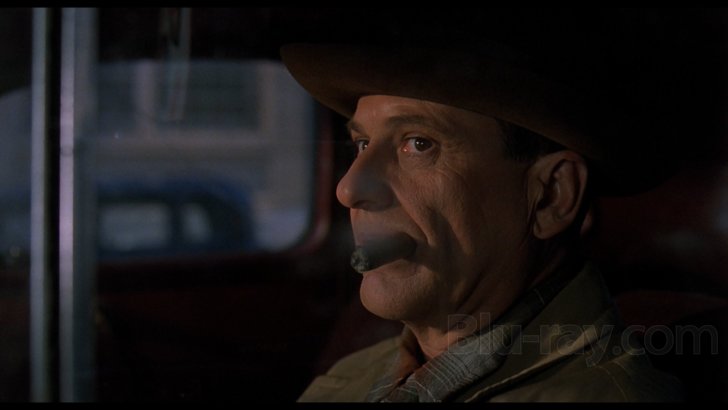
The loner
Joe Pesci’s character, Bernzi, is a replica of the notorious photographer Weegee, whose real name was Arthur Fellig. In the beginning of the last century his family immigrated to America from Złoczew, Austria (now part of Poland), and settled down in New York City, where by the 1930s everyone knew his work because his pictures routinely appeared in the biggest local newspapers. He gathered his pictures in five large albums, published them, and many are now viewed and collected as art.
The film does not explore the photographer’s early days. It introduces Bernzy as the best freelance photographer in New York City, or at least the one with the greatest instincts, and an essential piece of the ‘scene’ during the 1940s. He is always the first to capture with his camera the newest gruesome murder or attend the latest large social event where some of the city’s most prominent residents have come to mingle. The politicians, the gangsters, the cops, they all know him. Benrzy is the man with the camera that can make them look good -- even when some of them end up in a puddle of blood.
While working the streets, Bernzy crosses paths with Kay Levitz (Barbara Hershey), a beautiful middle-aged widow, who runs a popular night club and wants to find out why her husband was killed. Bernzy does not need another job to keep him busy, but Levitz’s request for help intrigues him and he agrees to look around and see if he can get some answers for her. Shortly after Bernzy goes to work, however, FBI agents pick him up and question his decision to become involved with Levitz, and then some really shady Italian mobsters warn him to stay away from her. Bernzy ignores the advices and while digging even deeper realizes that he has developed feelings for Lentz. As small pieces of information about the murder of Lentz’s husband emerge Bernzy then finds himself investigating a secret plan to wipe out a big mafia family, which could provide him with priceless pictures that will cement his reputation as the city’s greatest public eye or put him in a coffin.
There are only two significant differences between Howard Franklin’s film and the many classic film noirs from the 1940s and 1950s. The obvious one is that Franklin’s film was shot in color and some of its key locations aren’t real, so the noir ambience in it is slightly different. The other has to do with the identity of Mark Isham’s score. It is significantly lusher and more atmospheric than what would have been appropriate for a classic film noir. The rest is authentic noir material that easily could have been directed by masters like Robert Siodmak, Robert Parrish, and Jules Dassin.
The evolution of Bernzy’s relationship with Levitz is predictable, but the film isn’t focused exclusively on it. The different layers of the reality in which Bernzy operates actually become a lot more interesting to observe because they reveal the type of events that defined a society’s public image. In other words, the mystery surrounding the murder case as well as the drama that emerges from it are parts of a much bigger picture.
Excluding a few very short scenes where the photographer’s feelings for his client are slightly overemphasized, the film balances style and substance really well. Pesci and Hershey both look very convincing in a number of contrasting scenes, with the former in particular revealing a wide range of dramatic emotions that are guaranteed to surprise plenty of viewers. There is also a very large number of supporting actors, some of which are a-graders, whose contributions are invaluable.
Franklin worked with David Cronenberg’s regular cinematographer Peter Suschitzky, whose understanding of the important roles light and shadow have in film noirs produces some legitimately striking visuals. In fact, this writer was so impressed with the chic period look of the film that he has to speculate that had it been shot in black-and-white it almost certainly would have won numerous prestigious awards.
The Public Eye Blu-ray Movie, Video Quality 
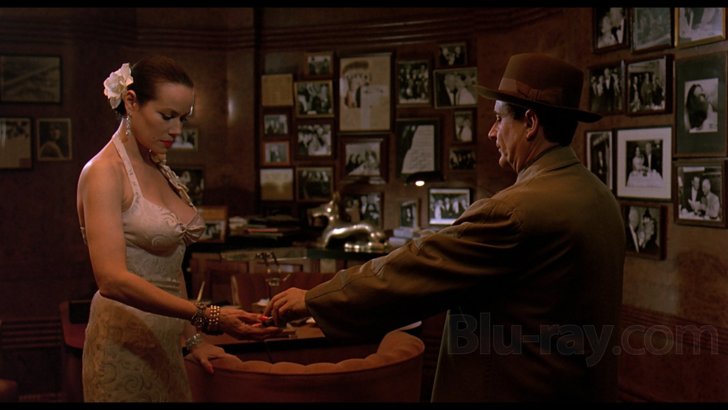
Presented in its original aspect ratio of 1.85:1, encoded with MPEG-4 AVC and granted a 1080p transfer, The Public Eye arrives on Blu-ray courtesy of Kino Lorber.
The release is sourced from an older master that reveals some of the typical issues we have to come expect when unrestored titles from Universal's catalog transition to Blu-ray. But there are some good news as well, and I will mention them first. The entire film looks spotless. Many darker close-ups reveal very nice depth and delineation, often with impressive clarity as well. There are fantastic ranges of primary colors and nuances, which lead me to believe that when the current master was prepared someone did a lot of careful work to ensure that the film looks as it should. The disappointing news is that most of the well-lit footage looks sharpened and harsh. The situation isn't as bad as it may sound, but on a larger screen the effect is impossible to miss (you can see examples in screencaptures # 11 and 12). Fluidity is very good, but the limitation I described above has a negative impact on it as well. (Note: This is a Region-A "locked" Blu-ray release. Therefore, you must have a native Region-A or Region-Free player in order to access its content).
The Public Eye Blu-ray Movie, Audio Quality 
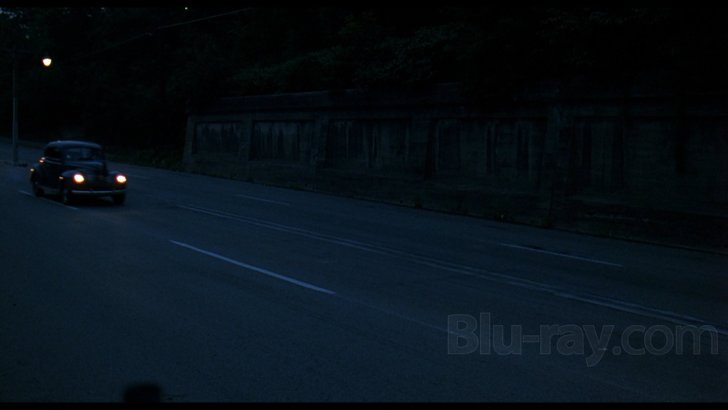
There is only one standard audio track on this Blu-ray release: English DTS-HD Master Audio 2.0. Optional English SDH subtitles are provided for the main feature.
There are no technical issues to report. On my system the lossless track sounded great and I was actually quite impressed with the variety of gentle nuances that I heard whenever Mark Isham's score became prominent. The dialog is very clean, clear, and easy to follow.
The Public Eye Blu-ray Movie, Special Features and Extras 
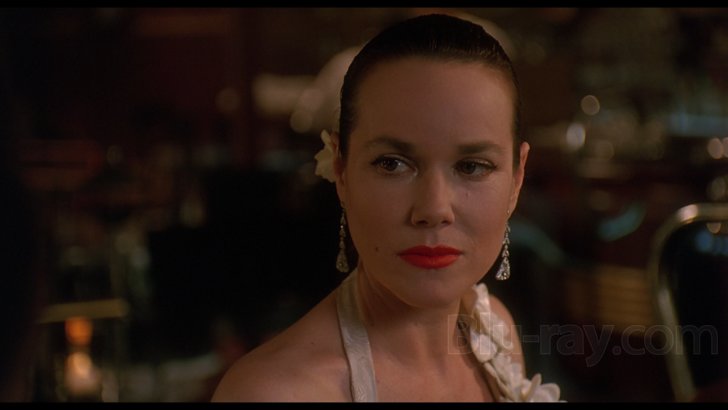
- Trailer - a vintage trailer for The Public Eye. In English, not subtitled. (2 min, 1080p).
- Commentary - in this audio commentary, director/writer Howard Franklin and filmmaker Daniel Kremer discuss in great detail the obstacles that had to be overcome before and during the shooting of The Public Eye, the casting choices that were made and specifically how Joe Pesci was brought on board, the different locations that were chosen for the film (with some very interesting comments about the Chicago locations), Peter Suschitzky's cinematography and the stylistic appearance of the film, etc. A wonderful commentary that should not be missed by fans of the film.
The Public Eye Blu-ray Movie, Overall Score and Recommendation 

It is unfortunate that Universal Pictures does not have a newer and better master for The Public Eye because there is so much to like in it. One of Joe Pesci's best performances is in this film, and Peter Suschitzky's work is quite special. Additionally, Jerry Goldsmith apparently wrote and recorded a soundtrack that was never used in the final version of the film, but I think that the one Mark Isham delivered is perfect. I like this film a lot, and while its transition to Blu-ray could have been quite a but better, I encourage you to consider picking up this release if you can find it on sale. RECOMMENDED.
Similar titles
Similar titles you might also like

State of Grace
1990

Force of Evil
4K Restoration
1948

Blast of Silence
1.85:1 and 1.33:1 aspect ratio presentations
1961

The Glass Key
1942

Kiss of Death
Limited Edition to 3000
1947

The Naked City
1948

Marked Woman
1937

Tomorrow Is Forever
1946

Blood on the Sun
1945

The Damned Don't Cry
Warner Archive Collection
1950

Summer of Sam
1999

On the Waterfront
1.66:1, 1.85:1, and 1.33:1 aspect ratio presentations
1954

The Window
Warner Archive Collection
1949

I Wake Up Screaming
Hot Spot
1941

Dead End
1937

He Walked by Night
4K Restoration
1948

The Man I Love
Warner Archive Collection
1947

The House on 92nd Street
1945

The Dark Corner
1946

Deception
1946
